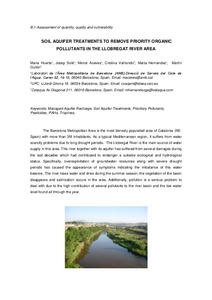Mostra el registre d'ítem simple
Soil aquifer treatment to remove priority organic pollutants in the Llobregat river area
| dc.contributor.author | Huerta, Maria |
| dc.contributor.author | Solé, Josep |
| dc.contributor.author | Aceves, Mercè |
| dc.contributor.author | Valhondo González, Cristina |
| dc.contributor.author | Hernández, Marta |
| dc.contributor.author | Gullón Santos, Martín |
| dc.contributor.other | Universitat Politècnica de Catalunya. Departament d'Enginyeria del Terreny, Cartogràfica i Geofísica |
| dc.contributor.other | Universitat Politècnica de Catalunya. Departament d'Enginyeria Hidràulica, Marítima i Ambiental |
| dc.date.accessioned | 2013-12-16T11:52:29Z |
| dc.date.available | 2013-12-16T11:52:29Z |
| dc.date.created | 2013 |
| dc.date.issued | 2013 |
| dc.identifier.citation | Huerta, M. [et al.]. Soil aquifer treatment to remove priority organic pollutants in the Llobregat river area. A: International UFZ-Deltares Conference on Groundwater-Soil-Systems and Water Resource Management. "Proceedings AquaConSoils Barcelona 2013". Barcelona: 2013, p. 1-7. |
| dc.identifier.uri | http://hdl.handle.net/2117/21002 |
| dc.description.abstract | The Llobregat River is the main source of water supply in this area. This river together with its aquifer has suffered from several damages which had contributed to endanger a suitable ecological and hydrological status; among them, pollution is a serious problem to deal with. In the last decades, the presence of organic pollutants in this river has been demonstrated [1,2]. Some of them are persistent to biological degradation and have shown to survive wastewater treatments almost unaltered and therefore they get surface waters where in some cases become recalcitrant pollutants. In order to mitigate the effect and presence of these compounds, Soil Aquifer Treatments (SAT) could be an approach since these treatments have demonstrated to be efficient to remove or decrease concentrations of such contaminants due to physico-chemical and biological processes occurring within the subsoil [3]. In the framework of the LIFE-ENSAT project, an organic substrate layer was installed in the basin of a recharge system located in the upper Llobregat delta aquifer. The aim was to enhance the degradation of contaminants through biochemical reactions on the reductive environment promoted in the unsaturated zone in order to improve the water quality of the system. In this work, the efficiency of this organic layer to remove organic pollutants included in European directives (2000/60/EC-2008/105/EC), such as triazines, pesticides or polyaromatic hydrocarbons (PAHs), has been evaluated. More than 80 compounds were analyzed; among them, 27 were priority pollutants while 6 were classified as preference substances (RD 60/2011). |
| dc.format.extent | 7 p. |
| dc.language.iso | eng |
| dc.subject | Àrees temàtiques de la UPC::Enginyeria civil::Geologia::Hidrologia subterrània |
| dc.subject.lcsh | Aquifers -- Spain -- Llobregat river area |
| dc.subject.other | Managed Aquifer Recharge |
| dc.subject.other | Soil Aquifer Treatments |
| dc.subject.other | Prioritary Pollutants |
| dc.subject.other | Pesticides |
| dc.subject.other | PAHs |
| dc.subject.other | Triazines |
| dc.title | Soil aquifer treatment to remove priority organic pollutants in the Llobregat river area |
| dc.type | Conference lecture |
| dc.subject.lemac | Aqüífers -- Contaminació -- Catalunya |
| dc.contributor.group | Universitat Politècnica de Catalunya. GHS - Grup d'Hidrologia Subterrània |
| dc.description.peerreviewed | Peer Reviewed |
| dc.relation.publisherversion | http://www.aquaconsoil.org/AquaConSoil2013/Proceedings.html |
| dc.rights.access | Open Access |
| local.identifier.drac | 12916793 |
| dc.description.version | Postprint (published version) |
| local.citation.author | Huerta, M.; Solé, J.; Aceves, M.; Valhondo, C.; Hernández, M.; Gullon, M. |
| local.citation.contributor | International UFZ-Deltares Conference on Groundwater-Soil-Systems and Water Resource Management |
| local.citation.pubplace | Barcelona |
| local.citation.publicationName | Proceedings AquaConSoils Barcelona 2013 |
| local.citation.startingPage | 1 |
| local.citation.endingPage | 7 |



